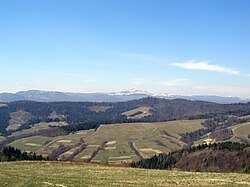
Veretskyi Pass
| Veretskyi Pass | |
|---|---|
| Верецький перевал | |
| Elevation | 841 m (2,759 ft) |
| Traversed by | Road |
| Location | Ukraine |
| Range | Carpathians |
| Coordinates | 48°49′37.55″N 23°10′32.76″E / 48.8270972°N 23.1757667°E |



Veretskyi Pass or Verecke Pass (Ukrainian: Вере́цький перевал, romanized: Veretskyi pereval, more formally: перевал Середньоверецький, pereval Serednoveretskyi, also known as: Ворі́тський перевал, Voritskyi pereval; Hungarian: Vereckei-hágó) is a mountain pass in Ukraine, one of the most important passes of the Inner Eastern Carpathian Mountains.

Location
The pass is located in the Carpathian Mountains just where the oblasts of Lviv and Transcarpathia meet, on the spine of the Northeastern Carpathians, between the Latorica (or Latorytsia) and Opir river valleys and at the river divide or watershed between the Latorytsia and the Stryi. It has an elevation of 841 meters.

History
The pass has been well-traveled for more than a millennium. In 895 the Hungarian tribes entered the Carpathian Basin and during the next century established the Kingdom of Hungary. In 1241 the main army of the Mongols crossed the pass into the Kingdom of Hungary. In 1703, when Francis Rákóczi II came back from exile at Berezhany Castle in present-day Ukraine, he traveled across Veretskyi Pass into the Hungarian Plain to assume leadership in an anti-Habsburg uprising which became known as Rákóczi's War of Independence.[1] In 1914 during the First World War the pass saw heavy fighting between Austrian-Hungarian troops and those of Tsarist Russia. During World War II the pass was the scene of further battles; the remains of the defensive fortifications of the Árpád Line can still be seen today. Since 1980 the pass has been bypassed by major highways.

In 2008, the Hungarian government received permission from the Ukrainian government to install a monument to the passing of the Hungarian peoples into the future Hungary (in 895). The monument was designed by Hungarian sculptor Péter Matl (Петро Матл) who was born in Mukachevo.

See also
References
- ^ Magocsi, Paul Robert: With Their Backs to the Mountains. A History of Carpathian Rus' and Carpatho-Rusyns. CEU Press, 2015
External links
- See a photo and map at Panoramio.
See what we do next...
OR
By submitting your email or phone number, you're giving mschf permission to send you email and/or recurring marketing texts. Data rates may apply. Text stop to cancel, help for help.
Success: You're subscribed now !



